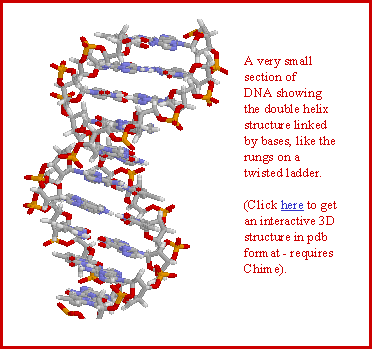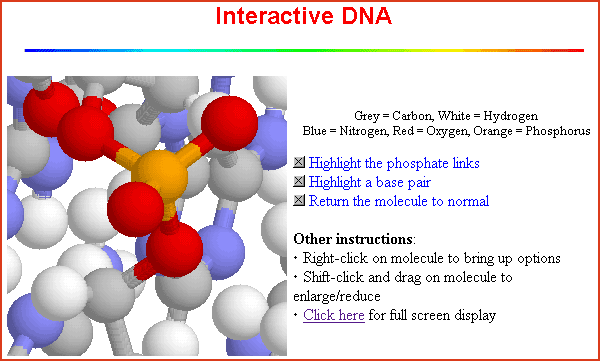| Search | Back Issues | Author Index | Title Index | Contents |
![]()
|
||
|
|
||
The Molecule of the Month website (http://www.bristol.ac.uk/ |

The image above was created using the plug-in Chime to manipulate the view of a DNA molecule on an interactive web page from the Molecule of the Month web site. The image is used with the permission of Dr. Paul May, School of Chemistry, University of Bristol, United Kingdom. |
|
The Molecule of the Month page came about as a result of a chance remark sent to the UK chemistry webmasters mailing-list. In November 1996, someone posted the suggestion that it might be a good idea if there were an electronic version of the 'Molecule of the Week' page that appeared in the Science column of the Daily Telegraph newspaper. Most people thought the idea of creating an electronic version sounded fun. I and a few others, including Henry Rzepa from Imperial College London and Karl Harrison from Oxford, decided to try and make the suggestion a reality, in the form of Molecule of the Month (MOTM) pages. We each chose different strategies for our pages. Henry wrote all of his MOTM pages himself and his pages highlight work that he, his colleagues, or his molecular modelling group have performed recently. Karl has also written his own pages, and as well as having pages about specific, individual molecules, he also includes collections of similar molecules and themed molecules (e.g., gemstones or vitamins). I decided upon a different approach. When Tim Berners Lee from CERN invented the web about 7 years ago, he envisioned a distributed information database, with parts of the information stored in different locations all over the world. To be true to this idea, I decided that my MOTM pages should be written by many different authors from as many countries and types of establishments as possible. I would only be responsible for maintaining the index of hyperlinks pointing to the various pages, and selecting those pages that would become Molecules of the Month. The Bristol MOTM page began in January 1996, with a contribution from Henry Rzepa of mauveine, the molecule that initiated the dye industry. As that year progressed, we managed to persuade more people to volunteer their time to create MOTMs, resulting in featured molecules as diverse as aspirin, ferrocene, and even water! 1996 also saw great advances in the technology of the web, most notably for chemistry with the introduction of the Chime plug-in for Netscape, and the java-based Chemsymphony. Both of these advances enabled 3-dimensional structure information of molecules to be displayed and manipulated in real-time on a web page. This allowed the MOTM pages to become visually quite stunning, with rotating molecules in stick or spacefill modes decorating the pages. The drawback was that not everyone had the appropriate plug-in or java-aware browsers necessary to see these 'enhanced' pages, and the solution was to provide several different versions of the pages, so readers could choose which page they wished to view. |
|

The image above was created using the plug-in Chime to manipulate the view of a DNA molecule on an interactive web page from the Molecule of the Month web site. The image is used with the permission of Dr. Paul May, School of Chemistry, University of Bristol, United Kingdom. |
|
In 2001, the MOTM page continues to flourish, with a new molecule being added every month. There are now over 60 pages each about a different molecule. The site is arguably one of the longest running on the web! Recent molecules have included Nandrolone (the anabolic steroid that caused controversy at the Olympics), Agent Orange (the notorious Vietnam War defoliant), Frankincense (the ancient Biblical perfume) and Thalidomide. Many of these pages are now being written by undergraduate students as part of their degree projects, so in this way the best projects obtain an exposure and readership, and also a permanence, hitherto unknown for student work. A new MOTM page typically gets 1000 hits in its first month. The number of hits drops down to about 200 per month from then on. This is quite good publicity for those who submit pages, and is therefore one of the incentives that inspires people to volunteer to do one. The current waiting list is about 3 months, so if you feel you'd like to contribute a MOTM, please email me with your suggestion. You can write about any molecule you like, so long as it's interesting and understandable by an undergraduate chemist. It can be a molecule you have worked on personally, or one that just takes your fancy. The MOTM page will continue only as long as enthusiasm persists among those who contribute -- so get writing! Paul May, February 2001 |
|
DOI: 10.1045/february2001-featured.collection |